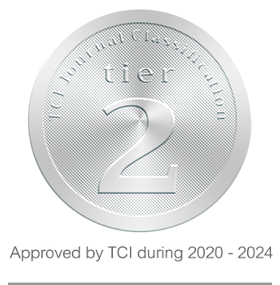Cultivars Clustering by Multivariate Analysis on Horticultural Characteristics of Yardlong Bean
Keywords:
Commercial cultivars, Genetic distance, Genetic divergenceAbstract
The success of plant phenotypic selection depends upon the range of genetic diversity available in the population. The objective of this research was to cluster 23 yardlong bean genotypes based on multivariate analysis of their horticultural characteristics. These genotypes consisted of 20 commercial cultivars, namely Naka, Greenarrow 692, Saifon, Nuethong 9, Saitara, Tarnthong, Lamnamphong 2, Suvarnabhum, Saisawan, Petkajee, Sornsawan 5, Moneygreen, Rangsit 888, Lamnamchee, Yodpetkasem, Airgreen 99, Munggornyok 9, Choiphiphop, Chiataisen, and Nigrodok, and 3 selected lines namely Green 33, Bangpra 2, and Purple 33. They were laid out in a randomized complete block design with 3 blocks under 2 seasons. Data were recorded for 12 horticultural traits and the mean values of traits from 2 growing seasons were used for multivariate statistical analysis by Mahalanobis distance (D2) method to study genetic divergence from those 12 traits, and the genotypes were grouped into clusters following Tocher’s method. The results revealed that the genotypes were classified into 5 clusters. Cluster 1 had the maximum (15) and cluster 5 had the minimum (1) number of genotypes. Cluster 4 had the highest intra-cluster distance (28.34) and the lowest in cluster 5 (0). The inter-cluster D2 values of five cluster revealed that the highest inter-cluster generalized distance (106.42) was between cluster 5 and cluster 1, while the lowest (33.38) was between cluster 3 and cluster 2. The percent contribution of each character towards divergence was as followings; pod length with the maximum contribution of 21.74%, followed by pod weight (18.58%), plant length (12.65%), number of pods per plant (11.46%), leaf width (5.53%) and pod width (8.70%), respectively.
References
Asoontha and Abraham, M. 2017. Variability and genetic diversity in yard long bean (Vigna unguiculata subsp. sesquipedalis). Int. J.
Curr. Microbiol. App. Sci. 6(9): 3646-3654. doi: http://dx.doi.org/10.20546/ijcmas.2017.608.448.
Bhagavati, P.P., Kiran Patro, T.S.K.K, Lakshmi Narayana Reddy, M., Emmanuel, N., Salomi Suneetha, D.R. and Vara Prasad, N. 2018. Studies on genetic divergence in yardlong bean (Vigna ungiculata (L.) walp. ssp. sesquipedalis Verdc.). International Journal of Chemical Studies 6(4): 1139-1142.
Bhandari, H.R., Bhanu, A.N., Srivastava, K., Singh, M.N. and Shreya, H.A. 2017. Assessment of genetic diversity in crop plants-an overview. Adv. Plants Agric. Res. 7(3): 279-286.
Department of Agricultural Extension. 2008. Agricultural Extension Academic Manual "Yard long bean". Available from: http://www.agriman.doae.go.th/home/t.n/t.n1/5vagetable_Requirement/08_long%20bean.pdf. [accessed on 27 Mar 2022]. (in Thai)
Department of Agricultural Extension. 2022. Report on agricultural statistics (Ror Tor. 01), vegetables group, country level. Available from: https://production.doae.go.th/site/login. [accessed 27 Mar 2022]. (in Thai)
International Rice Research Institute. 2014. Statistical Tool for Agricultural Research. Plant Breeding, Genetics and Biotechnology Division, International Rice Research Institute, Los Baños, Philippines.
Knott, J.E. and Deanon, J.R. Jr. 1969. Vegetable Production in Southeast Asia. Laguna: University of the Phillippines.
Makinde, S.C.O. and O.J. Ariyo. 2016. Multivariate analysis of genetic divergence in twenty-two genotypes of groundnut (Arachis hypogaea L.). J. Plant Breed. Crop Sci 2: 192-204.
Manivannan, N. 2014. TNAUSTAT-Statistical package. Available from: https://sites.google.com/site/tnaustat. [accessed on 23 June 2022].
Mohammadi, S.A. and Prasanna, B.M. 2003. Analysis of genetic diversity in crop plants-Salient Statistical Tools and Considerations. Crop Science 43: 1235–1248.
Morgan, M.T. and Wilson, W.G. 2016. Self-fertilization and the escape from pollen limitation in variable pollination environments. Evolution 59: 1143-1148.
Pélabon, C., Hilde, C.H., Einum, S. and Gamelon, M. 2020. On the use of the coefficient of variation to quantify and compare trait variation. Evolution Letters 4(3):180-188. doi: 10.1002/evl3.171. PMID: 32547779; PMCID: PMC7293077.
Poehlman, J.M. and Sleper, D.A. 1995. Breeding Field Crops: Fourth Edition. Iowa State University Press, Ames.
Porcher, M.H. 2015. Sorting Vigna names. Available from: http://www.plantnames.unimelb.edu.au/Sorting/Vigna.html. [accessed on 10 March 2015].
Purseglove, J.W. 1999. Tropical Crops: Monocotyledons , Volumes 1 and 2 combined. English Language Book Society and Longman, Singapore.
Rambabu, E., Reddy, K.R., Kamala, V., Saidaiah, P. and Pandravada, S.R. 2016. Genetic variability and heritability for quality, yield and yield components in yard long bean (Vigna unguiculata (L.) Walp. ssp. sesquipedalis Verdc.). Green Farming 7: 63-67.
Schoen, D.J. and Rowley, J. 2014. Self and cross-fertilization in plant. III. Methods of studying modes and functional aspects of fertilization. Int. J. Plant Sci. 153: 381-393.
Takashi, M. 2015. Azuki bean in Thailand: Research for production and marketing. pp. 21-22. IN: Proceedings for Azuki Bean and Production in Thailand. 28-29 January 2015. Chang Mai Green Lake Resort.
Tomooka, N. 2019. Genetic diversity and landrace differentiation of mungbean (Vigna radiate L.) Wilczek and evaluation of its wild relatives (The subgenus ceratotropics) as breeding material. Technical Bulletin on Tropical Research 28: 1-4.
United States Department of Agriculture. 2012. National nutrient database for standard reference, release 18. Available from:horttech.ashspublications.org/content/17/4/592.
United States Department of Agriculture. 2017. Vigna unguiculata (L.) Walp. subsp. sesquipedalis (L.). Verdc. Available from:http://www.ars-grin.gov/cgibin/npgs/html/taxon. pl?41646. [accessed on 19 April 2023].
Venujayakanth, B., Dudhat, A.S., Swaminathan, B. and Anurag, M.L. 2017. Assessing crop genetic diversity using principal component analysis: A Review. Trends in Biosciences 10(2): 523-528.
Downloads
Published
How to Cite
Issue
Section
License
Copyright (c) 2024 Songklanakarin Journal of Plant Science

This work is licensed under a Creative Commons Attribution-NonCommercial-NoDerivatives 4.0 International License.



